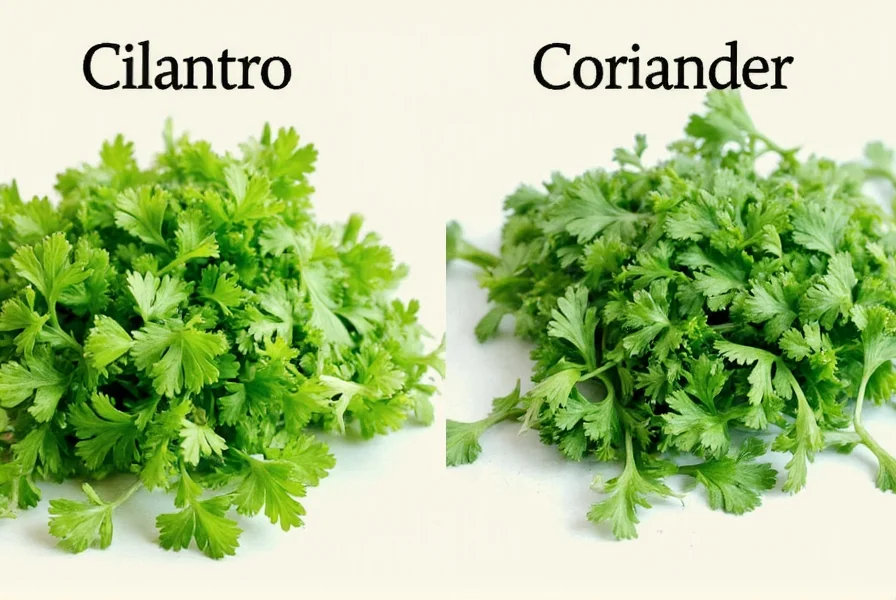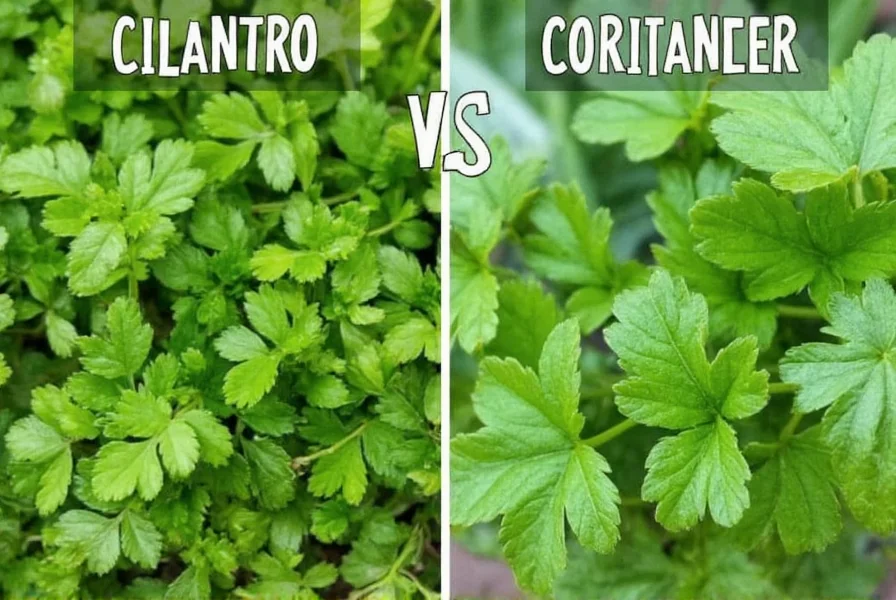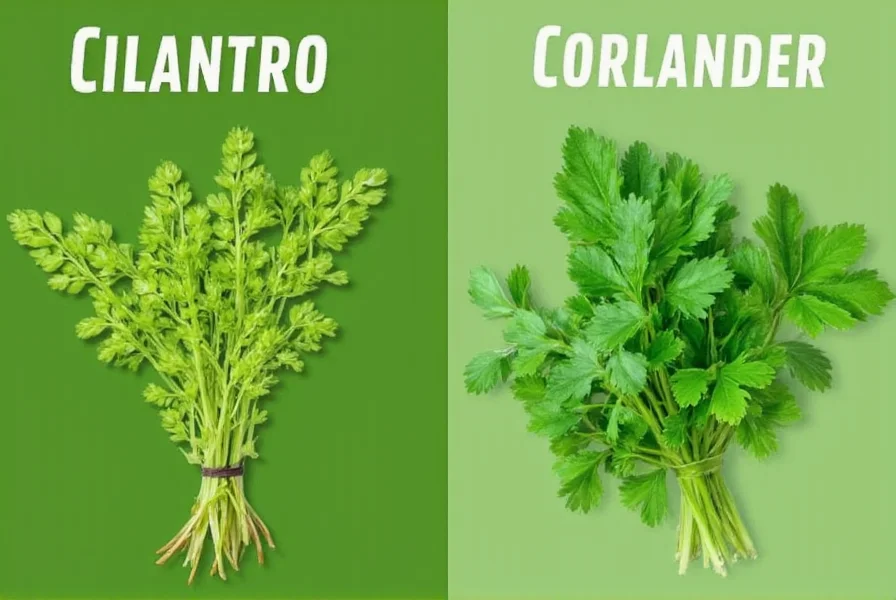Many home cooks and recipe enthusiasts find themselves puzzled when encountering both "cilantro" and "coriander" in cooking instructions. This confusion stems from regional terminology differences rather than botanical distinctions. Understanding this naming convention can transform your cooking experience and help you navigate international recipes with confidence.
Botanical Reality: One Plant, Multiple Names
The Coriandrum sativum plant produces both the fresh herb we call cilantro and the spice known as coriander seeds. This annual herb belongs to the Apiaceae family, which includes parsley, carrots, and celery. The entire plant is edible, but different parts serve distinct culinary purposes.
What many don't realize is that the terminology difference isn't about different plants—it's about which part of the same plant is being referenced and where the terminology originated. The word "coriander" comes from the Greek "koris," meaning bedbug, likely referencing the plant's distinctive scent. "Cilantro" derives from the Spanish word for the same plant.
Regional Terminology Breakdown
The naming confusion primarily stems from geographical differences in terminology:
| Region | Leaves/Stems | Seeds |
|---|---|---|
| United States | Cilantro | Coriander |
| United Kingdom, Canada, Australia, India | Coriander (leaves) | Coriander (seeds) |
| Spain, Latin America | Cilantro | Coriandro/Comino |
In most English-speaking countries outside the United States, "coriander" refers to both the fresh leaves and the dried seeds, with context determining which part is meant. This explains why British recipes might call for "coriander" when they mean the fresh herb, while American recipes would specify "cilantro" for the same ingredient.
Culinary Applications: Leaves vs Seeds
Understanding the difference between the plant parts is crucial for proper usage in cooking:
Cilantro (Fresh Leaves and Stems)
The fresh herb features bright, citrusy, and slightly peppery notes that work exceptionally well in salsas, guacamole, curries, and Asian-inspired dishes. Its flavor diminishes significantly when cooked, so it's typically added at the end of cooking or used raw as a garnish. The stems contain concentrated flavor and shouldn't be discarded.

Coriander Seeds
These round, tan seeds offer a completely different flavor profile—warm, nutty, and slightly citrusy with floral notes. When toasted and ground, they become a staple in spice blends like garam masala, curry powder, and pickling spices. Unlike the fresh leaves, coriander seeds maintain their flavor when cooked and are often used in baked goods, marinades, and preserved foods.
Practical Cooking Guidance
When following recipes from different regions, consider these practical tips:
- Check the recipe origin: American recipes using "coriander" likely mean the seeds, while British recipes using the same term might refer to the fresh herb
- Consider the context: If a recipe mentions "fresh" coriander, it's referring to the leaves; if it specifies "ground" or "seeds," it's the spice
- Understand substitution limitations: Dried cilantro doesn't adequately replace fresh, and coriander seeds cannot substitute for fresh cilantro leaves (and vice versa)
- Storage matters: Fresh cilantro lasts 1-2 weeks refrigerated (stored like flowers in water), while coriander seeds maintain potency for 6-12 months in airtight containers
Common Misconceptions Clarified
Several persistent myths surround this terminology:
Myth: Cilantro and coriander are different plants
Fact: They come from the exact same botanical source—Coriandrum sativum.
Myth: The term "coriander" always refers to the seeds
Fact: Outside the US, "coriander" commonly refers to the fresh herb, with context indicating which part is meant.
Myth: People who dislike "cilantro" would enjoy "coriander"
Fact: The soapy taste some perceive affects both the fresh leaves and, to a lesser extent, the seeds due to the same aldehyde compounds.
Global Culinary Significance
The coriander plant ranks among the world's oldest known herbs, with evidence of its use dating back to 5000 BC. Ancient Egyptians used it both culinarily and medicinally, while traditional Chinese medicine employed it for digestive issues. Today, it remains indispensable across global cuisines:
- Mexican cuisine relies heavily on fresh cilantro in salsas and guacamole
- Indian cooking uses both fresh coriander leaves and roasted seeds extensively
- Middle Eastern dishes feature cilantro in salads and as a garnish
- European baking often incorporates ground coriander seeds

Navigating International Recipes Successfully
When encountering unfamiliar terminology in recipes, consider these strategies:
- Identify the recipe's country of origin to anticipate terminology patterns
- Look for contextual clues ("fresh," "dried," "ground")
- Consider the dish's traditional preparation methods
- When in doubt, consult multiple recipe sources for the same dish
- Understand that some regional terms might use "Chinese parsley" for cilantro
For American cooks working with British recipes, remember that "coriander" likely means the fresh herb unless specified as seeds. Conversely, when following American recipes, "coriantro" always refers to the fresh herb, while "coriander" means the seeds.
Conclusion: Embracing the Terminology
The cilantro vs coriander distinction ultimately represents a fascinating example of how language evolves differently across regions while describing the same botanical reality. By understanding these naming conventions, cooks can confidently explore global cuisines without confusion. Whether you call it cilantro or coriander, appreciating both the fresh herb and its seeds expands your culinary repertoire significantly.
Is cilantro the same plant as coriander?
Yes, cilantro and coriander come from the exact same plant (Coriandrum sativum). Cilantro refers to the fresh leaves and stems, while coriander typically refers to the dried seeds. The terminology difference is regional rather than botanical.
Can I substitute coriander seeds for fresh cilantro in recipes?
No, coriander seeds cannot substitute for fresh cilantro. They have completely different flavor profiles and uses. Coriander seeds offer warm, nutty notes when ground, while fresh cilantro provides bright, citrusy flavor. In emergencies, you might use 1 teaspoon of ground coriander for 2 tablespoons of fresh cilantro, but the dish will taste significantly different.
Why do some people hate cilantro but like coriander?
People who perceive cilantro as soapy (due to a genetic sensitivity to aldehydes) often find coriander seeds more palatable because the concentration of these compounds is much lower in the seeds. The toasting process further breaks down these compounds, making the seeds acceptable to many who dislike the fresh herb.
How should I store fresh cilantro to keep it fresh longer?
Treat fresh cilantro like cut flowers: trim the stems, place in a glass with an inch of water, cover loosely with a plastic bag, and refrigerate. Change the water every 2-3 days. Properly stored, cilantro can last 1-2 weeks. Alternatively, chop the cilantro, mix with a little oil, and freeze in ice cube trays for longer storage.
What's the difference between coriander and Chinese parsley?
Chinese parsley is another name for cilantro/coriander leaves. The term appears in some Asian and European contexts to distinguish the fresh herb from other types of parsley. It refers to the exact same plant part as cilantro or fresh coriander leaves.











 浙公网安备
33010002000092号
浙公网安备
33010002000092号 浙B2-20120091-4
浙B2-20120091-4